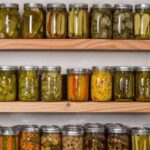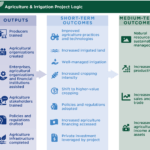Regenerative Agriculture Masterclass

Regenerative agriculture has gained popularity in recent years due to its focus on sustainability and environmental conservation. Unlike conventional farming methods, which often cause soil erosion, nutrient depletion and water pollution, regenerative agriculture focuses on the restoration and regeneration of agricultural ecosystems.
In this article, we will explore in depth what regenerative agriculture is, its benefits, the main concepts and related practices, as well as the tools and techniques used to implement it. We will also present some success stories in regenerative agriculture, as well as courses and training programs. In addition, we will provide free resources for those who wish to learn more about this revolutionary approach, so let's start our "Regenerative Agriculture Masterclass"!
- What is regenerative agriculture?
- The benefits of regenerative agriculture
- Principales conceptos y prácticas de la agricultura regenerativa
- Tools and techniques for implementing regenerative agriculture
- Success stories in regenerative agriculture
- Courses and training programs in regenerative agriculture
- Free resources to learn more about regenerative agriculture
- Our exclusive content on regenerative agriculture
- Conclusion and next steps for practicing regenerative agriculture
What is regenerative agriculture?
Regenerative agriculture is a holistic approach to farming that is based on the principles of ecology and permaculture. Unlike conventional agriculture, which focuses on maximizing short-term production, regenerative agriculture seeks to create healthy and sustainable farming systems for the long term. This is achieved by improving soil quality, water conservation, biodiversity and promoting environmentally friendly farming practices.
Instead of relying on chemical pesticides and synthetic fertilizers, regenerative farmers use natural methods to protect and improve soil health. These methods include crop rotation, no-till, composting, intensive grazing management, and crop-animal integration. In addition, regenerative agriculture encourages water conservation and the protection of natural resources by implementing strategies such as rainwater harvesting and efficient irrigation.
The benefits of regenerative agriculture
The adoption of regenerative agriculture practices can have a number of benefits for both farmers and the environment. These benefits include:
1. Improved soil health: Regenerative agriculture focuses on improving and maintaining soil health, which in turn increases water holding capacity, water infiltration, and nutrient availability to plants. This results in higher long-term agricultural productivity.
2. Conservation of natural resources: Regenerative agriculture promotes practices that protect and conserve natural resources, such as conserving water, protecting biodiversity, and reducing soil erosion. In doing so, it helps preserve agricultural ecosystems and maintain the health of surrounding ecosystems.
3. Improved climate resilience: Regenerative agricultural systems are designed to withstand extreme weather conditions, such as droughts or floods. By improving soil health and increasing biodiversity, these systems are better able to cope with climatic challenges and maintain agricultural productivity under adverse conditions.
4. Reduced reliance on chemical inputs: Regenerative agriculture seeks to minimize or eliminate the use of chemical pesticides and synthetic fertilizers, which reduces exposure to toxic substances and promotes soil and crop health.
5. Improved food quality: Regenerative farming systems often produce healthier and more nutritious food, as they focus on soil quality and biodiversity rather than short-term production maximization. This results in more nutrient-rich foods with less chemical residues.
Principales conceptos y prácticas de la agricultura regenerativa
Regenerative agriculture is based on a number of fundamental concepts and practices that help create healthy and sustainable agricultural systems. Below, we have highlighted some of the main ones:
1. Soil health
Soil health is fundamental in regenerative agriculture. It seeks to build and maintain fertile, living soils with high microbial activity and good structure. This is achieved through practices such as the use of organic fertilizers, soil amendment with compost and organic matter, crop rotation, and reduced tillage.
2. Biodiversity
Biodiversity plays a key role in regenerative agricultural systems. By encouraging diversity of plant and animal species in the agricultural ecosystem, it promotes interaction and collaboration between different life forms. This helps to increase the resilience of the system and reduce dependence on chemical inputs.
3. Crop rotation and cover crops
Crop rotation is a common agricultural practice in regenerative agriculture. It consists of alternating different crops on the same area of land throughout the growing seasons. This practice helps improve soil health, as different crops have different needs and contribute to nutrient diversity in the soil. In addition, cover crops, such as winter wheat or oats, are planted between the main crops to protect the soil, suppress weeds, and improve soil structure.
4. Water and resource conservation
Water conservation is an important aspect of regenerative agriculture. Regenerative farmers use efficient irrigation techniques, such as drip irrigation or rainwater harvesting, to minimize water use and reduce dependence on external supplies. In addition, practices are implemented to reduce soil erosion, such as terracing and direct seeding, which help conserve natural resources.
5. Integration of crops and animals
In regenerative farming systems, the integration of crops and animals is encouraged. Animals, such as cattle, chickens, and pigs, are managed sustainably and used to contribute to nutrient cycling. For example, animals can graze in specific areas to help fertilize the soil with their droppings, which in turn benefits the crops.
6. Composting and waste recycling
Composting is a common practice in regenerative agriculture. It involves the decomposition of organic wastes, such as crop residues, manure, and kitchen scraps, to create a nutrient-rich fertilizer that can be used on the land. Recycling waste is a way to close the nutrient cycle and reduce dependence on external inputs.
Tools and techniques for implementing regenerative agriculture
The implementation of regenerative agriculture requires appropriate tools and techniques. The following are some of the most common ones:
1. Conservation agriculture
Conservation agriculture is an agricultural technique that focuses on minimizing soil tillage to protect soil structure and reduce erosion. Instead of plowing the soil, methods such as no-till or minimum tillage are used, which help maintain soil health and reduce nutrient loss.
2. Synergistic farming
Synergistic farming is an agricultural approach that combines permaculture with market agriculture to maximize production and minimize environmental impact. This technique is based on the use of complementary crops and the creation of micro-ecosystems within the farming system.
3. Composting
Composting is an essential practice in regenerative agriculture. It consists of decomposing organic waste to create compost, a natural fertilizer rich in nutrients. This compost can be used to enrich the soil and improve its quality.
4. Rainwater harvesting
Rainwater harvesting is a technique that involves collecting and storing rainwater for later use in irrigation. This technique helps reduce dependence on water from external sources and conserve natural resources.
 Preserved Harvest Brand: Long-Term Food Storage Methods and Techniques
Preserved Harvest Brand: Long-Term Food Storage Methods and Techniques5. Urban agriculture and market gardening
Urban agriculture and market gardening are forms of regenerative agriculture that focus on growing food in urban and peri-urban areas. These practices promote local food production, reduced carbon footprint, and the creation of more sustainable communities.
Success stories in regenerative agriculture
Regenerative agriculture has been successfully implemented around the world, demonstrating its positive impact on soil health, agricultural productivity, and the environment. Below are some examples of success stories in regenerative agriculture:
1. Neversink Farm Course
The Neversink Farm Course is a regenerative agriculture training program offered by Neversink Farm, a farm in New York. During the course, participants learn about synergistic farming techniques, composting, water conservation and crop management to create sustainable regenerative farming systems.
2. Market Garden Institute
The Market Garden Institute is an organization that provides training and resources for farmers interested in market gardening and regenerative agriculture. Through online courses, workshops and educational materials, they help farmers implement sustainable and regenerative practices in their operations.
3. The Market Gardener Masterclass
The Market Gardener Masterclass, created by farmer Richard Perkins, is a comprehensive training program in market gardening and regenerative agriculture. Through videos, tutorials and lectures, participants learn about all aspects of regenerative agricultural production, from farm planning and design to crop management and marketing.
Courses and training programs in regenerative agriculture
If you are interested in learning more about regenerative agriculture, there are a number of courses and training programs available. These courses can help you gain the knowledge and skills you need to implement sustainable and regenerative practices in your own farming operation. Below are some of the most prominent courses and programs:
1. Neversink Farm Course: As mentioned above, the Neversink Farm Course offers training in regenerative agriculture through a hands-on, experience-based, on-farm approach.
2. Market Gardener Masterclass: The Market Gardener Masterclass by Richard Perkins is a comprehensive online training program covering all aspects of regenerative agriculture and market gardening.
3. Market Garden Institute: The Market Garden Institute offers a variety of online courses and workshops on market gardening and regenerative agriculture. These courses are designed for farmers of all experience levels, from beginners to professionals.
4. Synergistic farming: Synergistic farming is a specific approach to regenerative agriculture. There are several courses and programs available that focus on this particular technique.
5. Permaculture: Permaculture is a discipline that combines regenerative agriculture with sustainable design. There are numerous courses available that can teach you about the principles and application of permaculture.
Free resources to learn more about regenerative agriculture
If you want to learn more about regenerative agriculture but are not ready to invest in courses or training programs, there are a variety of free resources available online. These resources can help you get an introduction to regenerative agriculture and expand your knowledge. Here are a few examples:
1. Articles and blogs:
There are numerous blogs and websites dedicated to regenerative agriculture that offer informative and up-to-date articles on a variety of related topics. Explore these sources for valuable information and practical advice.
2. Documentaries and videos:
There are a variety of online documentaries and videos that explore regenerative agriculture and its benefits. These audiovisual resources can provide a more practical and visual insight into related concepts and practices.
3. Podcasts and interviews:
Many regenerative farmers and subject matter experts provide interviews and talks on podcasts and other digital media. These talks can provide detailed information and unique perspectives on regenerative agriculture.
Social media, such as Instagram and Facebook, are a quick and accessible source of information about regenerative agriculture. Follow regenerative farmers and related organizations for tips and frequent updates.
Our exclusive content on regenerative agriculture
At [website name], we are committed to promoting regenerative agriculture and disseminating useful information and resources. Through our exclusive content, we provide in-depth articles, practical guides, and interviews with regenerative agriculture experts. Our goal is to provide you with the knowledge and tools you need to implement sustainable and regenerative practices in your own farming operation.
In addition to our exclusive content, we also offer links to courses and training programs in regenerative agriculture. These resources will allow you to deepen your knowledge and access additional information from experts in the field.
Conclusion and next steps for practicing regenerative agriculture
Regenerative agriculture represents a more sustainable and environmentally friendly way to grow food. By focusing on soil health, resource conservation, biodiversity and the integration of crops and animals, it offers significant benefits for both farmers and the environment.
If you are interested in practicing regenerative agriculture, we encourage you to start by exploring the free resources and links to courses we provide on this page. Take the opportunity to learn more about the principles and practices of regenerative agriculture and consider implementing these approaches in your own farming operation.
Remember that adopting regenerative agriculture is not an instantaneous change, but a gradual process. However, over time, you will see the benefits of increased soil health, greater climate resilience and higher quality of the food you produce. So start your journey to regenerative agriculture today and be part of the shift to a more sustainable food system.
 The efficient and cost-effective approach to farming practices
The efficient and cost-effective approach to farming practices
Leave a Reply